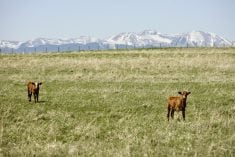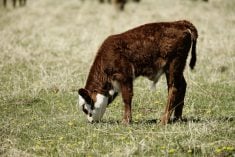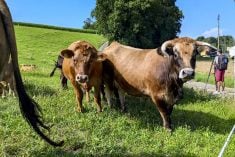Collecting DNA samples for parentage testing from bulls and the resulting calves from multi-sire breeding pastures is the only way to find out each bull’s value to your operation. A bull might come with a great package of traits you want to see passed to your calves, but the bull’s value is questionable if the calves fall short of expectations. A bull that breeds only a few cows clearly isn’t worth much at all.
“Our big findings so far are that a lot more bulls out there are doing less on the job than we think and we can’t blame it all on known traits like age,” says Stacey Domolewski, a University of Saskatchewan masters candidate who has been working with six Saskatchewan ranchers to evaluate whether sire verification is practical and economically feasible for large commercial herds.

She and the ranchers knew going into the study that performance would vary among individual bulls; however, the degree of differences was unexpected considering that all of the bulls had passed their breeding soundness evaluations.
“If producers had thought that a bull would only sire a few calves, they would have culled the bull before breeding season. None of the bulls were questionable, yet we see that as long as a bull passed the semen test, a higher score didn’t necessarily result in more calves sired,” Domolewski says.
The surprise was that some of the young (yearling) bulls sired as many or more calves than the mature (three years and older) bulls.
“We expected the younger bulls to sire fewer calves, and overall, young bulls are siring fewer calves, yes, but there is a lot more variance among mature bulls. Some sired three times more than expected and others sired only a couple of calves,” she explains.
Read Also

Body condition, nutrition and vaccination for brood cows
One of the remarkable events of the past century related to ranching has been the genetic evolution of brood cows….
A sample set of one year’s data from one herd shows that there were four mature bulls, one two-year-old bull and one yearling bull with 147 cows in one of the breeding groups. One of the mature bulls sired 53 of the 128 calves sampled, while another sired only 10. The other two sired 20 and 28 calves. The two-year-old had the poorest showing with only five offspring and the yearling sired 11 calves.
In another breeding group with two mature bulls and two yearlings with 83 cows, one mature bull sired 24 of the 70 calves sampled. The yearlings sired 15 and 19 to outdo the other mature bull with 12 calves to its credit.
Domolewski calculates a breeding proficiency index (BPI) for each bull to compare its performance across all breeding groups in the six participating herds. The BPI is based on the bull-to-cow ratio in each breeding group. If, for example, the ratio was 1:25, then 25 calves would be expected. If a bull sired more calves than expected, the BPI is higher on the index. Those that sired fewer than expected ranked lower with zero being the baseline.
The challenge for her study and producers alike is the long interval between breeding and having calves on the ground to sample.
Calves were sampled for the most part during routine spring processing, making it nip and tuck to have the large set of results back in time to make culling decisions before the start of the immediate breeding season.
Sampling calves at weaning might be an option for those who handle calves before or at weaning. In the meantime, however, the bulls would have already sired another set of calves without producers knowing how well each is performing, Domolewski explains.
Producers now have two years of their own test results in hand and Domolewski is working on the overall compilation to wrap up her thesis in the first part of 2017. Others will carry on with the study for at least one more test year under the guidance of her supervisor Dr. Bart Lardner.
On the Ranch
Two ranchers participating in the study, Karmen McNabb of Eastend, and Leanne Thompson of Ceylon, have shared their insights with producers at events during the year.
McNabb and her husband, Jason, run 450 cows in the Cypress Hills of southwestern Saskatchewan. Thompson and her husband, Ryan, have 800 cows and 500 to 600 calves in their feedlot in the far south of central Saskatchewan.
They agree that collecting the samples is actually the easiest part of parentage testing. Tail-hair samples from bulls need only be collected once in the animal’s lifetime and this can be done whenever they are handed for other procedures. Likewise, the labour and time requirement for taking ear-tissue samples from the calves is minimal when done during routine handling.
The time lag between breeding and being able to use the results, along with merging the results with herd management records to be able to make the best use of the information are the larger challenges.
McNabb says it has been a real eye-opener to find out that some bulls are working really hard and some aren’t doing much of anything even though all of the bulls passed their breeding soundness evaluations. For instance, one yearling produced 54 calves while in a pasture with five other bulls. In another group, the four-year-old bull they figured would be king of the mountain sired four.
“So, in theory, parentage testing is a really good idea. Practically, it’s tricky to manage,” she says. The downside is that it’s slow just because of the natural breeding cycle topped off with timing the sampling to have test results back ahead of breeding season. If the decision is made to cull any of the bulls, even a week or two in advance of turnout isn’t enough time to find quality replacements because most bull sales have come and gone by then.
She’s thinking that staging their brandings to collect and submit samples for testing in smaller groups as calving season progresses might be an option for their ranch because they manage spring processing on their own with the use of a handling system and tipping table. Although they wouldn’t have the big picture until all calves had been tested, this strategy should at least give them enough information to identify trends well ahead of breeding season.
Whether parentage testing will be economically viable based on bull-culling decisions alone remains to be seen. The McNabbs typically buy yearling bulls and keep them for three to four years on average. They have culled one bull because of the low number of calves it sired both years of the project; however, the practicality of waiting for two years of results to make culling decisions is questionable when most bulls have only a year left by then anyway.

They are leery of culling a young bull due to one poor year when other factors such as pecking order may have been at play and the bull could very well have at least two good years ahead.
Use of one sample to test for parentage plus other traits of importance to their ranch might be the best way to get the most value from genetic testing, she adds.
Overall, she feels that the effort put into sire verification has been worthwhile because it has provided enough information to spot big differences and trends. It has been interesting to find out whose calf is whose, and more so now that they’ve introduced bulls of a second breed to find out what each breed is contributing to their operation as far as calf weaning weight goes.
There again, weaning weights have to be considered in the big-picture context because there can be significant year-to-year differences due to factors other than the bull’s genetics, such as weather conditions, time of calving, and to a lesser degree, cow-calf mixups.
McNabb is confident that her records are as accurate and complete as can be for a large commercial herd. As she puts it, “real life happens” when the cows are calving on pasture and sometimes newborns end up with the wrong dam.
Checking up on heifer bulls
The Thompsons had already been considering parentage testing as a potential management tool when the opportunity came along to participate in the study.
Leanne Thomson says the main use so far has been to solve calving issues with the heifers. Even though they select calving-ease bulls for use on heifers, the genetics don’t always hold true and the year before the study was a prime example with lots of trouble due to big calves.
The first year of the study, she started collecting samples as the heifers calved from any calves that were weak, lazy, got sick or if the heifer had trouble calving to get an early indication as to whether certain bulls were the cause of the problems.
“It has proven useful already. Just solving the calving trouble issue alone has been well worth it,” Thompson says. “The next step, if we continue to sample all of the calves, I think, will have to be to use the information in more ways by developing a performance metric to identify certain bulls for use as terminal sires for feeder cattle and certain bulls that turn out the nicest heifer calves for replacements.”
Since parentage-test results aren’t in report form useable for this kind of purpose right off the bat, she suggests that it’s important to have someone who is comfortable with using computers and herd management programs who can clear the time to dedicate to record keeping in order to be able to use the information to its full advantage.
Unfortunately, she was left searching for a new herd management program after receiving notice toward the end of summer that the software they had been using was about to be discontinued. With that came the onerous task of transferring nearly three years of records into a new program and making sure everything was working as it should. The light at the end of the tunnel now is the flexibility and features of the new program in that it is a web-based product that doesn’t require installing updates and information can be accessed from anywhere including by smartphone out in the field.
It does track sire and dam parentage with reporting options to analyze the data.
She adds that the quality of the samples does make a difference as to how quickly the results come back and the completeness of the results, although there will always be non-matches for reasons other than poor samples, such as a cow that jumps in with a neighbouring herd or the neighbour’s bull visiting your herd.
For future reference, it’s wise to note known incidents such as these as they happen along with reasons for pulling any bulls during the breeding season so that the details won’t slip your mind later on. It’s also important whenever possible to collect tissue samples from calves that die to have a complete picture of each bull’s value as a sire and be able to detect issues over the longer term.
Collecting samples
Quantum Genetix at Saskatoon, Sask., is running the analyses for the study. Research director Steven James explains that pulling approximately 25 hairs from the tail switch of each animal is an easy and efficient way to sample bulls and cows. Keeping in mind that it’s the skin cells attached to the root end of the tail hairs that are needed to run the test, use needle-nose pliers to give a sharp tug upward against the lay of the hair pulling five to 10 strands at a time and checking to make sure the bulb of skin on the root remains intact.
Clip off wet or soiled hair that could spoil the sample and seal each animal’s sample in its own paper envelope or bag, label it with the animal’s identification number from your records (dangle tag management number, Canadian Cattle Identification Agency electronic identification tag number, tattoo), and store the samples in a cool, dry place until sending them to the lab.
Ear tissue samples are recommended for calves because the tail hairs are so fine that it’s difficult to get enough skin cells with them for testing. The tissue samples are collected with tagging pliers that place a small punch of skin directly into a barcoded and numbered Quantum collection tag. Samples must be accompanied by a list of corresponding animal identification numbers. These samples need to be put in the freezer as soon as possible, kept frozen until shipping, and sent or delivered to the lab the quickest way possible, preferably in an insulated container with freezer packs so that they remain cool during transport.
Instructions for taking hair and tissue samples are available on Quantum’s website under the submission-forms tab, where prices for various tests can also be found. In addition to parentage testing, Quantum offers testing for genes associated with performance traits (leptin, tenderness, fat deposition, ribeye area, stress response and appetite), inheritance of red and black coat colour, polled and horned traits, and genetic defects. Package pricing can be discussed if more than one type of test is required for each sample, James adds.
The cost of the Quantum tissue collection tags is included in the price of the test, currently at $12 per animal. Skin-tissue tagging pliers can be purchased for $75.
For record-keeping convenience, Quantum tags and CCIA electronic identification tags with matching numbers can be ordered together from the CCIA for roughly $4 per set. The Quantum tag with the CCIA number stays with the sample and the CCIA tag is applied with the appropriate tagger in another spot on the ear.
James says turnaround time for parentage testing depends on the number of samples submitted and the number of work orders ahead of yours. As a general guideline, allow about a week for up to 100 samples and four weeks for up to 500 samples.
For more information, visit quantumgenetix.com, or call 306-956-2071.

















